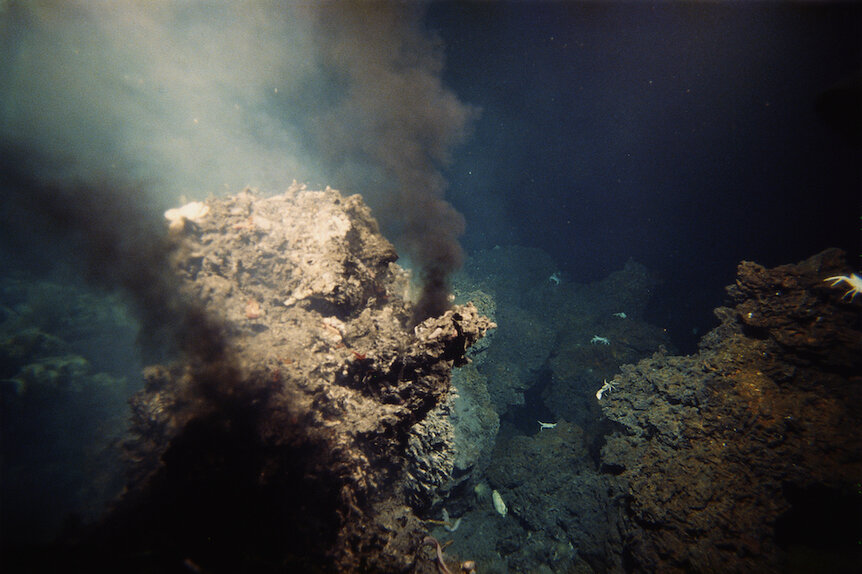Create a free profile to get unlimited access to exclusive videos, sweepstakes, and more!
NASA Discovery Could Mean Mars Had Life-Supporting Hydrothermal Vents
The Perserverance rover keeps racking up the wins on Mars!
We’re not totally sure where Harry Vanderspeigle – Alan Tudyk’s extraterrestrial character on SYFY’s Resident Alien, (new Season 3 episodes air on Wednesdays) – comes from, and not for lack of trying. We do know that his species shares some genetic relationship with the cephalopods of our own world, so there’s a good bet Harry’s home world has water, and lots of it.
On Earth, it’s likely that life first emerged in the oceans, possibly fed by volcanic vents from deep inside the planet. Anywhere you’ve got liquid water, a source of energy, and minerals for doing interesting chemistry with, you’ve got the basic ingredients for life. Just next door, on Mars, a team of scientists recently found evidence of similar hydrothermal activity at what’s left of an ancient lakebed.
For More on Mars:
NASA Seeking Applicants for Next CHAPEA Simulated Mars Mission
NASA's Perseverance Spies Damaged Ingenuity Helicopter on Mars
Could You Really Fake a Mars Landing? The Science of Capricorn One
Martian Lakes May Have Been Fed by Volcanic Vents
NASA’s Perseverance rover is a giant remote-control car currently roaming a crater on the Red Planet. It was sent to Jezero, a crater 28 miles (45 kilometers) across, because scientists believe that crater once held an ancient lake. Geological evidence in and around the crater suggests that a river once flowed into the crater, and it could have sustained liquid water for hundreds of thousands or millions of years. If life was going to spring up anywhere on Mars, Jezero is the sort of place it might happen, but life needs more than a crater and some water, and that’s where volcanoes come in.
We know that Mars was volcanically active once, it is home to the largest volcano in the solar system, the towering Olympus Mons, which might still be volcanically active today. Jezero Crater has two igneous formations to its name, called Séítah and Máaz. The rover investigated those formations using its Habitable Environments with Raman & Luminescence for Organics & Chemicals (SHERLOC) and the Planetary Instrument for X-Ray Lithochemistry (PIXL) instruments and found evidence of sulfate-rich fluid alteration on the crater floor.
Sulfur and sulfur minerals create a stink here at home, but they can help scientists unravel the story of Martian geology and inform whether it was ever suitable for life. The results of their study, published in the Journal of Geophysical Research: Planets, suggest the minerals were deposited during several hydration episodes, meaning it was wet in Jezero Crater more than once.
Combing through spectral data from Perseverance, researchers found signatures of calcium sulfate and hydrated magnesium sulfate, similar to Epsom salts. They suggest that those crystalline minerals may have formed when water flowed through cracks in volcanic rock some 3.8 billion years ago. One possible explanation for the crystals’ presence is hydrothermal activity like that seen in the deep oceans. On Earth, deep sea hydrothermal vents provide an oasis of warmth and nutrients in the dark deserts of the deep sea. There, large crystals of sulfate materials often form under high temperature hydrothermal conditions.
That could mean that Jezero Crater was not only covered in a lake of liquid water, but it was also fed by volcanic activity which added heat and minerals into the system. Of course, there are other ways the minerals may have gotten there. Acidic groundwater might have dissolved mineral-rich rocks and then deposited those minerals elsewhere. We don’t really know.
To find out for sure, and to see if there are any microscopic alien fossils hiding out in those rocks, we’re going to have to bring samples home and look for ourselves. Right now, Perseverance is gathering rocks samples for retrieval during a future sample return mission. When we finally get our hands on those Mars rocks, we might be able to answer the question of alien life once and for all.
Until then, catch up with everyone’s favorite extraterrestrial on Resident Alien; new episodes air Wednesdays at 10/9c on SYFY, and next day on Peacock..




































